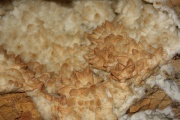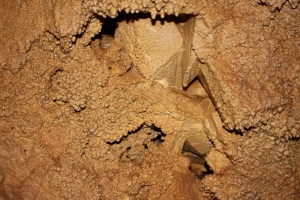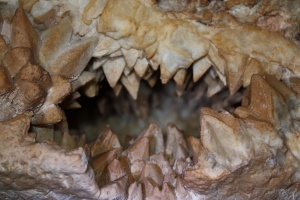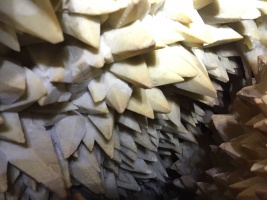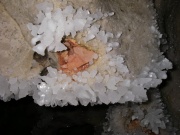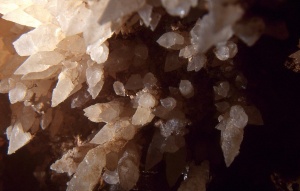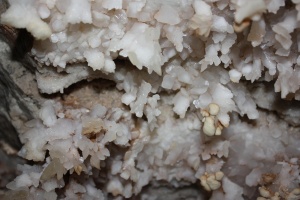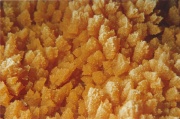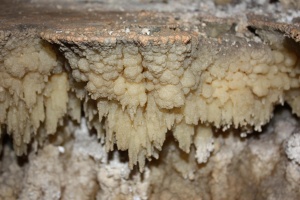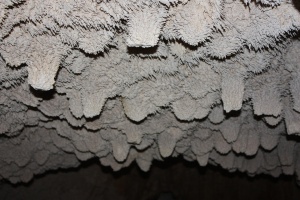Calcite (Inventory)/Spar
From LagWiki
Spar crystals are classified as to their form.
Contents |
dogtooth
The dogtooth field should be used to list stations which exhibit dogtooth spar crystals.
Dogtooth spar is a crystaline speleothem usually of calcite. The shape is scalenohedral -- triangular facets -- with pointed ends. The size can vary from barely discernable to quite large. The color can vary too. Often only one end of the scalenohedron may be visible giving each crystal a pyramid-like shape. Sometimes, both ends of the crystal can be seen forming a kind of faceted football shape. They can occur singularly or in clusters. They can often be found lining the insides of vugs or cavities and cracks but can also occur on the ceiling or walls directly. Since they formed when the cave was phreatic, they can be obscured by other formations such as flowstone, popcorn, crusts or staining. When looking for dogtooth spar, take the time to look into cracks and vugs in the walls, floor and ceiling. And don't forget to examine breakdown -- it may possess a vug containing dogtooth spar. Often when dogtooth spar is found, it can be found at nearby stations, too.
If the shape of each crystal does not seem to be scalenohedral but is more complex, you may be seeing nailhead spar.
See also
References
- Hill, Carol; Paolo Forti (1997) Cave Minerals of the World (Second Edition ed.) National Speleological Society p 101 ISBN: 1-879961-07-5
- Palmer, Arthur N. (2007) Cave Geology CAVE BOOKS, Dayton, OH p 275 ISBN-13: 978-0-939748-66-2, ISBN-10: 0-939748-66-5
dogtooth, Spar, Calcite
nailhead
The nailhead field should be used to list stations which exhibit nailhead spar.
Nailhead spar typically is "flatter" or more "cubic" than dogtooth spar with blunt ends. The shape is a combination of a rhombohedron where each facet is a rhombus, and a scalenohedron where each facet is a triangle. This is basically a combination of the two primary crystaline shapes of calcite in a single crystal. Pure rhombohedral calcite (rhomb spar) has no specific field on the form and should be inventoried as nailhead. Except for the shape of each crystal, nailhead spar has characteristics very similar to dogtooth spar and can be found in similar locations.
Nailhead spar can occur singularly; but are usually found in clusters. They can be found lining the insides of vugs or cavities and cracks but can also occur on the ceiling or walls directly. They formed when the cave was phreatic so individual crystals can grow to be quite large; but, are usually small. They can be obscured by other formations such as flowstone, popcorn, crusts or staining. When looking for nailhead spar, take the time to look into cracks and vugs in the walls, floor and ceiling. And don't forget to examine breakdown -- it may possess a vug containing nailhead spar.
See also
References
- Hill, Carol; Paolo Forti (1997) Cave Minerals of the World (Second Edition ed.) National Speleological Society p 101 ISBN: 1-879961-07-5
- Palmer, Arthur N. (2007) Cave Geology CAVE BOOKS, Dayton, OH p 275 ISBN-13: 978-0-939748-66-2, ISBN-10: 0-939748-66-5
nailhead, Spar, Calcite
chenille/pool
The chenille/pool field should be used to list stations which have pool spar crystals.
Pool spar are well-defined crystals that grow under the surface of pools of water. They may be found lining the floor, sides and under shelfstone of pools and dry pools. Chenille spar are a subset of pool spar. Individual pool spar crystals are rarely large and most often small but the clusters of crystals can line the entire underwater surfaces of a pool.
Chenille spar are long drapery-like crystaline formations which form just below the water surface. They are closely related to pool fingers -- both have the same origin, calcite crystals growing on microbial filaments. The primary difference between pool fingers and chenille spar is that chenille looks more like a drapery while pool fingers are more finger-like. Chenille spar rarely gets more than a meter in length and individual crystals are usually so small as to make the formation look velvety.
Look for pool spar and the chenille variety of pool spar anywhere pools have formed or may have once been. Be sure to examine under shelfstone and ledges that may be covering the pool and hiding the spar. It doesn't take much of a pool to form pool spar. Pool spar can even form between the gours in a series of rimstone dams.
See also
References
- Palmer, Arthur N. (2007) Cave Geology CAVE BOOKS, Dayton, OH p 297 ISBN-13: 978-0-939748-66-2, ISBN-10: 0-939748-66-5
- Hill, Carol; Paolo Forti (1997) Cave Minerals of the World (Second Edition ed.) National Speleological Society p 101 ISBN: 1-879961-07-5
chenille/pool, Spar, Calcite
Pool spar and chenille spar. The shelfstone may be listed as a restoration project. |
